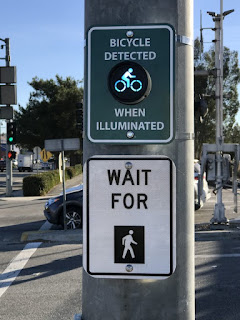 |
| Photo by Owen Zwiliak, Chicago Sun -Times |
A few of my recent posts have dealt with drivers' and cyclists' attitudes about, and perceptions of, each other. As I've described, irate motorists see us as over-privileged scofflaws who endanger the public order.
At least one person perceives otherwise. James R. Anderson, a Chicago cyclist, wrote a letter to his hometown newspaper, the Sun-Times about drivers who behave badly. As he correctly points out, they are a more egregious danger to cyclists and pedestrians than we can be to them in part because they are driving two to four tons of metal, often at two to four times the speed at which we ride (not to mention how much faster and more massive they are than pedestrians). But he makes another point: Too many motorists (including drivers of pickup trucks and SUVs) are looking at their screens rather than their surroundings; they, and other drivers sometimes block crosswalks or bike lanes and blow through red lights, seemingly oblivious to the fact that they've done anything wrong.
Oh, and he also brings up another little-discussed fact: That most fatal crashes are caused by drivers, not cyclists or pedestrians. For one thing, even in cities like Chicago and New York with large numbers of cyclists, we are far outnumbered by drivers. And a driver's error or carelessness can be magnified to a much greater degree--because of the vehicle's speed and mass--than any misjudgment a cyclist or pedestrian could make.
To spare you from having to navigate a paywall, I am reproducing Anderson's letter here:
I have seen letters to the editor recently from car drivers complaining about “sharing the road with bike riders while bike riders break all kinds of laws.” The letter writers say they’ve seen bicycle riders run stop signs.
My question is: Have they seen the behavior of car drivers? Last week on Hubbard Street, I was stopped at a stop sign — because it’s a stop sign and because there was a pedestrian in the far crosswalk — and three drivers buzzed around me to blow the stop sign and endanger the pedestrian.
Drivers in giant SUVs and pickup trucks, with no idea what’s happening around their vehicles because they’re too busy playing with their phones to have a look or check their mirrors, run red lights with alarming frequency. I don’t mean they just missed the yellow; the light was red, and they decided to go anyway.
Drivers turn right on red without stopping or looking for pedestrians on the right, often in contravention of “No turn on red” signs.
Drivers block bike lanes and crosswalks and fail to stop for pedestrians in crosswalks, with no idea they’re doing anything wrong.
By the way, it is drivers, not bicycle riders, who usually cause car crash fatalities, including more than 1,300 in 2021. Plus, they inflict injuries great and small, plus cause billions in property damage.
Bad bicycle riding is inexcusable, but its impact is microscopic compared to the harm of bad car driving. It’s like the difference between a nuclear missile and a fly swatter.
James R. Anderson, Near West Side











